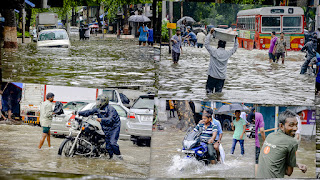Catastrophic Industrial Disasters and evidences: Genetical Deformations and Pain of India
The economic growth of a country mostly
depends upon the eminent core industries like oil and gas. The processes in these industries include
manufacturing, packaging, transportation, disposal, and storage. These
processes are dealt with hazardous chemicals with corrosive, inflammable,
radioactive, genetic susceptible chemicals, with explosive characteristics. The
rough handling, spillage, and leakage of these chemicals can lead to accidents,
serious casualties, loss of properties, and damages. India has witnessed many
major and minor chemical accidents in the last century. These industries are prone to hazards and
accidents entitled to Major Accident Hazard (MAH) industries.
These accidents are unpredictable, so the
prior identification and probability of occurrence need to be studied. The
potential risk due to the sudden leakage of hazardous chemicals needs to be
calculated with effective preparedness which can reduce human vulnerabilities
and environmental pollution.
Bombay Docks Explosion, Maharashtra (1944)
During the rage of World War II, Mumbai
witnessed two explosions at Victoria Dock on a British freighter on board, SS Fort
Stikine on 14th April 1944. The cargo was carrying the dreaded
combinations of ammunition and inflammatory substances, 1400 tons of
explosives, mines, torpedoes, and shells, and also it had cotton bales, oil
barrels, and timbers as the fire agitators. In addition, the cargo was carrying
gold bullion bars of 31 crates worth billion euros.
The accidental fire break on Stikine with two
explosions spread to the nearby population and tremors were recorded up to
Himalayan regions. Several residents and thirteen surrounded cargo ships were damaged.
The lethal Bombay Dock explosion recorded fatalities of 800 people, 305 of
which were in dockyard and fire services. The explosion was remembered as the
deadly and strongest fire explosion till the world witnessed the Hiroshima
Nagasaki Nuclear explosion. The day is celebrated as the Fire Brigade Day to
pay tribute to the fighters of the day.
Chasnalla Mining Disaster, Jharkhand (1975)
The thein Chasnalla Colliery was owned by India
Iron and Steel Company (IISC) and later on merged with Steel Authority of India
Limited (SAIL). The explosion was caused in the mining area on 27th
December 1975 at the outskirt area of Dhanbad, now Jharkhand causing ignition
of methane gas which led to mine collapse and reservoir blast with a water
staggering rate of 7 million gallons per minute. The explosion reported around
700 fatalities and billions of economical losses. The incident was minutely
investigated and the accused were punished by the Govt of India in 2012 marking
the safety of mine workers.
The Union Carbide Gas Tragedy, Madhya
Pradesh (1984)
The photos say
about the abandoned Union Carbide factory with rusted tanks, units, and
hundreds of broken brown unknown residues of chemical bottles. The Carbide gas
tragedy happened on December 3, 1984, with an accidental leakage of 40 tons of
toxic gas within 45 to 60 minutes from the pesticide plant controlled by Union
Carbide India Limited (UCIL) in Bhopal, Madhya Pradesh. More than 5 lakhs of people
behind the factory walls were exposed to methyl isocyanate (MIC) causing severe
infection in the respiratory tract, throat, and eyes. More than 5 lakhs in and
around the factory were injured and more than 16000 people have died since the
tragedy. The tragedy was a subsequent accident of many chemical accidents from
1976 to 1982 in the factory which caused leakage of MIC, Chlorine, monomethyl
amine, phosgene, carbon tetrachloride, and mercury-based chemicals. The tragedy
increased the rate of stillbirth to 300% and the neonatal mortality rate to
around 200%. The toxic gas affected the victims with long-term health issues, the
female ovary and uterus were affected, and chromosomal mutations and
neurological disorders rate increased over years. The subsequent legal actions
were taken during 1990 - 1991 by Govt of India punishing the accused and
settlements for the victims.
Hindustan Petroleum Corporation
Limited (HPCL) fire, Andhra Pradesh (1997)
We all know the
corporation is on the list of fortune 500 companies with billions of turnovers
every year. The corporation deals with major refineries with a wide variety of
petroleum fuels and subsidiaries. The refineries are in the states of
Maharashtra, Andhra Pradesh, Karnataka, and Rajasthan Punjab.
The blast in the
crude oil refineries cum petrochemical complex of HPCL, Vishakhapatnam on September 14, 1997,
was caused due to leakage of the LPG pipeline which was carrying gas from the
port to the refineries. The massive sound due to the blast and thick smoke
caused panic among nearby residents. The blast reported 55 fatalities with 10 people
injured. The HPCL infrastructure lost 500 million rupees and products worth 200
million. There was another similar incident in the refinery in the year 2013
with 25 fatalities.
Korba Chimney Collapse, Chhattisgarh
(2009)
The incident
occurred on September 23, 2009, in Korba, Chhattisgarh in an under-construction
area under contract for the Bharat Aluminum Co Ltd (BALCO). The incident
happened during a thunderstorm and torrential rainfall collapsing the
under-constructed 240 m high chimney. The torrential rainfall slowed down the
rescue work and reported 45deaths of workers who have taken shelter in the area
during the bad weather. The 275 m
chimney was planned to be constructed by Gannon Dunkerley & Company Limited
(GDCL) for Shandong Electric Power Construction Corporation (SEPCO) for a
thermal power plant run by Vedanta Resources, BALCO. Almost after 3 years in
2012, the accused were punished by the Indian Govt for using substandard
materials in the chimney construction.
Jaipur Oil Depot Fire, Rajasthan
(2009)
The primary fire
explosion in Indian Oil Corporation Limited (IOCL) Jaipur depot was reported on
29th October 2009 as a result of the leak of motor spirit or
gasoline from a valve of a pipeline. The fire broke out for around 80 mins
caused a powerful explosion which led to a large fireball at a temperature of
around 1727 degrees centigrade surrounding the depot with a high blast
pressure. The explosion shattered the window glasses over a radius of 3 km. The
fire takes in around 81 tonnes of gasoline which is equivalent to 38 tonnes of
Trinitrotoluene. The incident reported 12 fatalities and 200 people injured
with damages to assets worth $ 60 million. India Meteorological Department
(IMD) reported a seismic tremor of 2.3 Richter scale around the area and the Ministry
of Petroleum and Natural Gas stated the incident as the first major Vapor cloud
explosion (VCEs) accident in India and the third reported in the World.
Mayapuri Radiological Accident, Delhi
(2010)
The gamma radioactive
accident happened in West Delhi, Mayapuri. The area was the hub of heavy metal industries
during the incident, which dealt with the metal scrap market, metal factories,
and automobile service garages. This serious radiological accident occurred in
April 2010 when a Gamma cell 220 research irradiator of Atomic Energy of Canada
Limited (AECL) owned by Delhi University, was auctioned and the unused
irradiator arrived in the Scrapyard of Mayapuri. The source of a radioactive
substance, cobalt-60 caused 11 fatalities due to radioactive injuries. The incident
was indexed as 4 out of 7 on the International Nuclear Events. After the accident,
eLORA (e-Licensing of Radiation Applications) was being implemented by Atomic
Energy Regulatory Board (AERB) for automation of the regulatory process.
Ammonia gas
leak at Manan Cold Storage, Gujarat (2013)
The Ammonia gas
leak at Manan Cold Storage, Ranasar, Gujurat reported 7 fatalities and million losses.
Around 65 people trapped inside the factory were rescued by IFFCO and ONGC
teams. The leakage was from the pipeline carrying ammonia gas to the factory. The case was investigated and ex-gratia money was
given to victims and injured persons by the factory owners.
Sterlite
copper smelter gas leak, Tamil Nādu (2013, 2018)
The Rs. 41,000
crore smelter was the country’s biggest producer of domestic copper of more
than 3 Lakhs tonnes per year. After the gas leak on 23rd March 2013 and
the protest of local people, the plant was investigated by District Health
Officials and found unsatisfactory concerns. Following this, the Tamil Nadu
Pollution Control Board fined 10 million euros in 2013 and ordered the shutdown
of the Sterlite Industries copper plant at Tuticorin in 2018 which is the
result of 22-year-long campaigning by anti-Sterlite activists, environmentalists,
and local residents. The industry is a part of London-based Vedanta Resources. The
health effects on plants, animals, and human beings were found with the 20
times high range of dissolved solids in terms of copper and iron found in
groundwater and was beyond the acceptable limit as per the Central Pollution
Control Board. The local residents suffered from respiratory diseases and
cancerous growth due to copper pollution.
The national
asset plant was catering to around 40% of the national demand for domestic
copper and was contributing Rs. 2500 crore to the govt exchequer. After 4 years
of closure of the plant, in 2022, Vedanta Resources invited the expression of
interest to buy the enveloped plant with the smelter complex, sulphuric acid
plant, copper refinery, copper rod plant. Phosphoric acid plant, caprice power
plant, oxygen unit, amenities complex, and the expansion project worth 4 Lakhs
metric tonnes per annum.


.jpg)

















